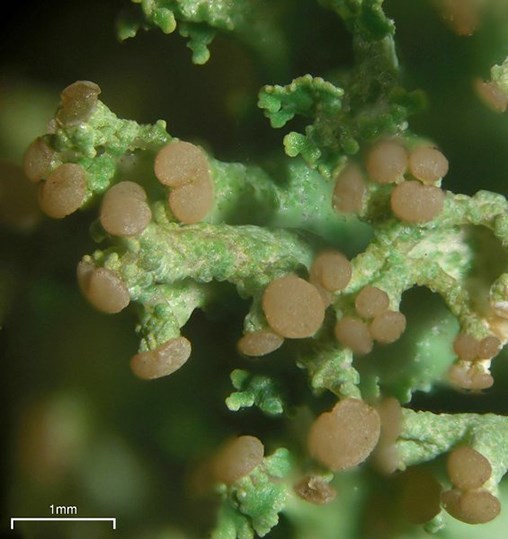Last updated: May 20, 2025
Article
Dragon Cladonia

CURTIS BJÖRK, WAYS OF ENLICHENMENT
General Description
By imagining a dragon with numerous horns on its head and a scaly neck you might easily recognize the lichen Cladonia squamosa, the dragon cladonia, or “dragon horn.” You’ll want to get as close as possible to admire its weird beauty and the strange formations protruding from its scaly body. What you’ll see is more like a multi-headed creature instead of a single dragon alone in its lair. And you’ll be perfectly safe.
As with other species in the genus Cladonia (fungal family Cladoniaceae, order Lecanorales), dragon cladonias have two parts, a basal primary vegetative body (squamule) and an erect, hollow, secondary vegetative body (podetia) that usually develops from the surface or edge of the squamule. Cladonias form mats or clumps and may cover large areas on soil, rocks, trees, and on top of mosses. Cladonias are composed of a green algae in the phylum Chlorophyta and a fungus in the Ascomycota.

Jason Hollinger, Ways of Enlichenment
C. squamosa forms colonies of overlapping (imbricate), finely divided, grayish or brownish green squamules with simple to sparsely branching, densely scaly (squamulose), pale gray-green podetia 1–5 cm tall. The tips of the podetia may be blunt or open into narrow cups. Tan to brown fruiting structures at the tips are sometimes present. The dragon cladonia is highly variable and can be challenging to identify at first. Two characteristics help to distinguish it from similar looking species: its scaly podetia and its ultraviolet light fluorescing medulla, the fungal layer found underneath the outer green algae-containing cortex. The fungal tissue in this layer contains squamatic acid, which will glow blue-white when exposed to ultraviolet light (UV+).
Habitat and Distribution
Dragon cladonias are found worldwide in temperate regions. They are locally common in moist forests at low to mid elevations, most often in shady sites but sometimes in exposed sunnier sites where colonies will appear overall more brown than green.
Ecology
Dragon cladonias may grow in distinct colonies but more usually are interspersed in a community with other cladonias, mosses, and vascular plants with which they share similar habitat requirements. Dragon cladonias possess mechanisms that allow them to adapt to extreme conditions of high light and low moisture. They thrive best where they don’t have to compete with thick or tall vegetation. All cladonias protect the soil from erosion and contribute to its biomass.

Jason Hollinger, Ways of Enlichenment
Reproduction
Lichens in general face distinct reproductive challenges. In cladonias, the tip of the podetia is “the business end,” where the sexual fruiting structures called apothecia, if they occur, grow. Even well-developed podetia may never produce apothecia. Vegetative reproduction via diaspores (soredia), propagules composed of fungal tissue and algal cells, is rare in this species. So if both soredia and apothecia are uncommon, how is the dragon cladonia reproducing, as it surely must be? These ideas leave another choice, though perhaps not the only one, and that is fragmentation. Pieces of the lichen containing both fungal and algal tissue break off and are carried by wind, water, or animals to other locations. Can you think of other ways lichens may reproduce?
Lichens are Ecosystems
We hear a lot about human microbiomes these days. Microbiomes describe the genetic material of bacteria, viruses, fungi, and other organisms that live on or inside our bodies. In short, we are veritable ecosystems. Like humans, lichens are ecosystems too, though on a miniature scale. Cladonia squamosa lives in Antarctica and in a recent study of lichens there the species was considered a model organism for the study of microbiome composition. Microbial diversity increased from the top of the podetia to the squamules growing at the base in colonies of dragon cladonias on King George Island. The basal part of the lichen offers a more stable and moist environment where several species of algae, fungus, and bacteria were able to thrive.
Where to See
Dragon cladonias grow in Redwood NSP, Oregon Caves NMP, and quite likely in moist wooded sites at most of the other parks in the Klamath Network. Let us know if you find it!
Learn More
Lichen reproduction and dispersal:
https://www.anbg.gov.au/lichen/reproduction-dispersal.html
King George Island study:
Microbiome in Cladonia squamosa is vertically stratified according to microclimatic conditions
Download a pdf of this article
Prepared by Kasey Rolih
NPS Klamath Inventory & Monitoring Network
Southern Oregon University
1250 Siskiyou Blvd
Ashland, OR 97520
Featured Creature Edition: March 2021
Thumbnail image credit: CURTIS BJÖRK, WAYS OF ENLICHENMENT
